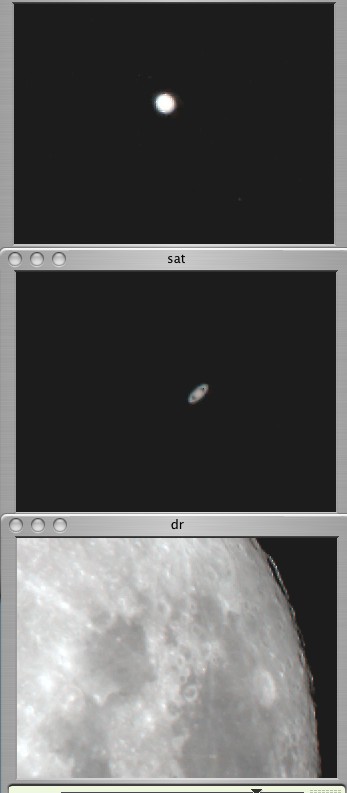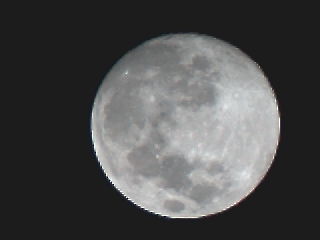
MEADE LPI WITH MAC OS X
Last updated: 26 November 2011
This page discusses using the Meade Lunar Planetary Imager with Mac OS X. Contributions welcome.
[26 November 2011]
Mike here: As a cloudy day project, I installed a Sonix driver for my old LPI per the instructions provided by Stephen Wangner below on my MacBook Pro with Mac OS X 10.7.2 (Lion). See my Cassiopeia Observatory report for 23 November 2011 to see how it went.
End of today's update
Subject: Meade LPI with Mac OSX 10.6.4 (Snow Leopard) Sent: Tuesday, September 7, 2010 12:58:49 From: Stephen T. Wangner (steve@wangner.net) Last week while cleaning out my storage room, I came across the box containing an old Meade LPI that I had purchased a few years back. After MUCH research out there on the net and even more experimentation, I was able to get the LPI working on my MacBook Pro running OSX 10.6.4 in two different ways: Using my original AutoStar Suite installation CD, I was able to fully install the software and drivers in a VMWare Fusion virtual machine running WinXP. Since this is my option of last resort (I much prefer to have Mac-native solutions), I did even more research and experimentation and found that: The Sonix SN9C102 (not SN9C102p) driver (available as a download from the Sonix site, and I also kept a copy) properly installs and functions in OSX 10.6.4. After installing the SN9C102 driver, I was able to use the LPI Mac-native through Keith's AstroImager. I just finished the installation and testing today, so I don't have any astronomical images yet. If the weather holds up here in NY, I might be able to get some tonight or tomorrow night. Jupiter's beautiful right now and is at opposition on the 21st (I believe it's the 21st) so that's going to be my first target. The driver is available at: http://www.sonix.com.tw/sonix/download.do?d=4843,2 You can also get there by: 1. go to http://www.sonix.com.tw/sonix/downloadSearch.do 2. in the "Select Product Family" drop-down, choose "Video/Image Controllers" 3. in the "Select Product Series" drop-down, choose "PC-CAM Controller" 4. in the "Select Product" drop-down, choose "SN9C102 (Phase out)" 5. in the second column, check the checkbox next to "Drivers" 6. in the third column, click on the "Submit Search" button. 7. when the search returns, click on the Chinese characters next to " SN9C101/102_v1.00_MacOSX (805KB)". The file may want to initially save with no file extension. If it does, add ".zip" (it's a zip file in reality). If you have any questions, etc. please don't hesitate to ask. It works for me and it should be a repeatable thing. P.S. I am also a big fan of Crossover - I did try it, and it did install and run the AutoStar software, but it appears that it won't see the LPI correctly. But with being able to get it working Mac-native, that became a non-issue.Mike here: I hope to give this driver a try soon with my LPI on my MacBook Pro.
End of 8 September 2010 update
End of 23 November 2009 update
Subject: Meade LPI, a Mac and Mars Sent: Tuesday, November 1, 2005 07:16:24 From: Tom Mordasky (mordaskyt@mac.com) So yesterday I picked up the Meade LPI to connect to my ETX90. I had been using my Canon Powershot A80 with a homemade adaptor but the results were mediocre at best. I connected the LPI to my iBook g4 using the Sonix driver discussed on your site and here: http://www.cloudynights.com/ubbthreads/showflat.php/Cat/0/Number/643660/Main/622738 Some people have had trouble downloading this software, claiming the site requires a password. It seems strange but when I went to the link in the Firefox browser I could not download the driver without a password, but in Apple's Safari it downloaded fine??? Who knows why... Connection was easy and I was imaging Mars in no time. Of course I have no idea what settings to use with the Sonix software but "Default" seemed a good place to start. Attached you will find my first composite shot of Mars taken with the ETX90, The Meade LPI and a 2x Barlow for a whopping 400x magnification! 300 of 350 images stacked in Lynkeos.Mike here: Eyepiece projection will be difficult (no lens on the LPI) but you can use a Barlow Lens with it.Next I want to A: figure out the camera settings and B: see if there is any way to use it via Eyepiece projection to widen its field of view.
And:
Further working with the stack I managed to get this shot...This is my best 100 or so out of 750 Not bad.
End of 4 November 2005 update
Subject: LPI Mac OS X driver Sent: Thursday, September 29, 2005 11:48:08 From: Lyle Scheer (wonko@monkeyhouse.org) I've been looking at the following page on your web site: http://www.weasner.com/etx/astrophotography/2005/lpi-osx.html It makes me want to try this, but it looks like sonix has removed the os9/mac os x driver from *their* website. I don't suppose you have a copy of the driver floating around and can email it to me? - - Lyle ScheerMike here: I presume it is still there; you just need to register an account with their site.
Subject: Meade DSI with Mac Software Sent: Thursday, August 25, 2005 23:50:13 From: Joerg Mueller (JoergSO.Mueller@t-online.de) I live in Germany, use an ETX 125, one LX 200 GPS and a Meade LPI. On your ETX sites I found software for an Apple PowerBook, Mac OS X. The driver for the LPI camera works fine. I know that you have a Meade LPI and not a DSI. But do you know now if there is a Mac Software for the DSI. Thank you for ansering Best wishes, clear sky JoergMike here: I haven't heard of one yet but I seem to recall someone was working on an open source driver for Mac OS X.
End of 3 October 2005 update
Subject: lpi first light Sent: Tuesday, January 25, 2005 18:58:38 From: Tom Mesquitta (tom@mesquitta.com) About an hour and a half ago, i accessed your website, and saw your new post regarding the lpi on a Mac. This was really strange, as i emailed you a few days ago, having had problems with autostar not recognising the lpi, then a few days later, this god send was posted. Even though it was nearly 1:30 am over here in England, i couldn't resist going outside and trying it out on my ETX-125. The seeing conditions were quite poor with cloud obstructing then clearing the view of the telescope every few minutes, and as i had not planned to go out, i couldnt really drive half hour to my nearest (slightly darker) area, so i had to settle for the back garden. Nevertheless, i managed to take my first three astrophotos! (jupiter with satellites, saturn and the moon). Anyway i better get to bed now as ive got a university lecture in a few hours. Tom. Oh p.s is there anyway to adjust the exposure times of the lpi with this driver, or is it just movies that its able to do?Mike here: As I noted on the writeup below, the driver monitor application has a video setting where you can adjust the exposure.
End of 27 January 2005 update
Subject: LPI driver for mac Sent: Sunday, January 23, 2005 09:40:54 From: Rodolphe Pineau (pineau@rti-zone.org) I found that while looking for something else on the net. It gives a link to a driver that allow the LPI to work on Mac OS X and OS9 Link to the thread : http://www.cloudynights.com/ubbthreads/showflat.php/Cat/0/Number/297818/Main/251739 Link to the driver page : http://www.sonix.com.tw/sonix/product.do?p=SN9C102 Rodolphe -- | Rodolphe Pineau RTI-Zone | | http://www.rti-zone.org/ | | Coldfire Robot / Unix / Atari / Astronomy |



Return to the top of this page.
Go back to the Astrophotography Page.
Go back to my ETX Home Page.